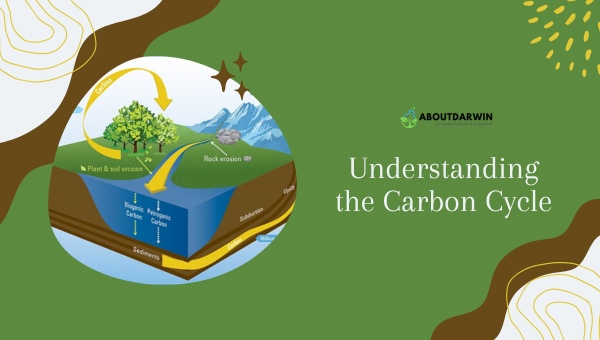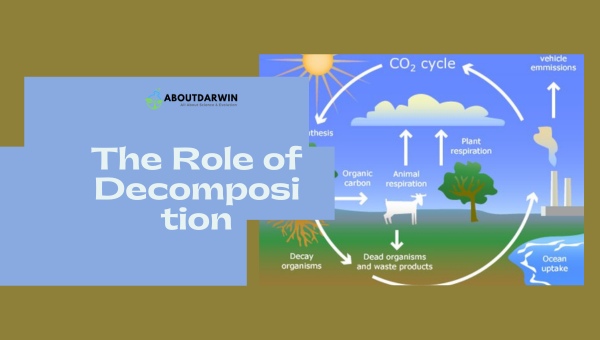Physical Address
304 North Cardinal St.
Dorchester Center, MA 02124
The carbon cycle plays a crucial role in our planet’s ecological balance by regulating carbon dioxide levels, a greenhouse gas that contributes to global warming. As our world continues to face the challenge of climate change, understanding the carbon cycle, including photosynthesis, decomposition, respiration, and combustion, grows increasingly important.
Photosynthesis, the process by which plants convert sunlight into energy, plays a key role in the carbon cycle. During this process, plants absorb carbon dioxide from the atmosphere and release oxygen, helping to reduce carbon dioxide levels.
In contrast, decomposition, the breaking down of dead organic matter, and respiration, the process by which living organisms release energy from food, release carbon dioxide back into the atmosphere. Combustion, or the burning of fossil fuels, also contributes to releasing carbon dioxide.
In essence, the carbon cycle involves the continuous movement of carbon between the Earth’s atmosphere, biosphere, and geosphere. A complex yet vital process, it helps to maintain a sustainable balance between the production and consumption of this essential element on our planet.
Contents
The carbon cycle is a crucial process in our global ecosystem. It’s a series of interconnected processes by which carbon, an essential element for life, cycles through the atmosphere, oceans, land, and living organisms. Let’s break down the main components of this fascinating cycle.

Photosynthesis is the process by which green plants, algae, and some bacteria convert carbon dioxide (CO2) and sunlight into glucose (a simple sugar) and oxygen (O2). This process enables plants to create the energy they need for growth and reproduction. The following equation represents photosynthesis:
6CO2 + 6H2O + Light Energy → C6H12O6 (Glucose) + 6O2
Decomposition, on the other hand, is the breakdown of organic materials, such as dead plants and animals, by decomposers like bacteria and fungi. These decomposers break down the organic compounds into simpler forms, ultimately releasing CO2 back into the atmosphere.
Respiration is the process by which living organisms, including plants and animals, consume oxygen to release stored energy from glucose, creating CO2 and water as by-products. Similar to decomposition, respiration also releases CO2 back into the atmosphere.
Combustion is the process of burning fossil fuels, such as coal, oil, and natural gas, to release energy. This process releases both CO2 and water vapor into the atmosphere. The increase in CO2 emissions from human activities, primarily the burning of fossil fuels, has significantly contributed to climate change.
These interconnected processes ensure a continuous flow of carbon among reservoirs. Some key reservoirs of carbon include:
By understanding the carbon cycle, we can better appreciate its importance in maintaining the balance of our planet’s ecosystems. It’s essential to recognize human activities significantly impact the carbon cycle, and we must make informed choices to promote sustainability and combat climate change.
When we think about the carbon cycle, it’s essential to understand the importance of photosynthesis. I’ll dive into this critical process, explaining its role in our ecosystem and why it’s vital for life on Earth.

First, let’s clarify what photosynthesis is. It’s a process where plants, algae, and some bacteria convert sunlight, water, and carbon dioxide into glucose and oxygen. This reaction creates the energy and oxygen necessary for these organisms to grow and survive, serving as the food chain’s primary source of organic matter.
Photosynthesis benefits our environment in various ways:
To put things into perspective, let’s take a look at some photosynthesis-related data:
| Percentage of Earth’s Oxygen Produced | Photosynthetic Organism |
|---|---|
| 50% | Ocean phytoplankton |
| 28% | Tropical rainforests |
| 18% | Temperate deciduous forests |
| 4% | Boreal forests |
You may see this; Photosynthesis is a fundamental process that incrementally shapes our world. From the smallest algae to the mightiest of trees, these humble organisms convert the sun’s energy into life-essential resources. By understanding the importance of photosynthesis, we can begin to appreciate and protect these valuable ecosystems that keep our planet in balance.
Decomposition plays a crucial role in the carbon cycle, and it’s essential to understand how it influences carbon dioxide levels within our ecosystem.

In decomposition, organic compounds break down by the actions of bacteria and fungi, resulting in the release of carbon dioxide (CO2) into the atmosphere.
Various factors affect the rate of decomposition, such as temperature, moisture, and the type of organic material. For instance, warmer temperatures and higher moisture levels typically increase the rate of decomposition, whereas materials like woody plants take longer to break down compared to soft plants or dead animal tissue.
During the decomposition process, decomposers like bacteria, fungi, and other microorganisms consume organic materials that contain carbon. These materials include dead plants, animals, or waste products.
As these decomposers break down complex organic structures, they release carbon in the form of CO2, and other products like water (H2O), nutrients, and more. This process is vital to the overall carbon balance in ecosystems, as it helps recycle carbon back into the atmosphere.
Moreover, decomposition influences soil fertility by releasing nutrients, mainly nitrogen and phosphorus, into the ground. These nutrients are essential for promoting plant growth, which in turn captures more carbon from the atmosphere through photosynthesis. Consequently, decomposition contributes to establishing a natural loop in the carbon cycle.
Understanding the role of decomposition in the carbon cycle provides valuable insight into sustainable land use practices and helps identify potential strategies for mitigating climate change by harnessing the power of natural processes.
Respiration, as an essential part of the carbon cycle, plays a vital role in regulating global carbon levels. It’s the process by which living organisms, including myself, convert organic matter (usually glucose) and oxygen into carbon dioxide and water, releasing energy in the process. This energy fuels a cell’s various activities, ranging from growth and repair to reproduction.
The carbon dioxide released during respiration returns to the atmosphere, eventually participating in other stages of the carbon cycle. In fact, plants and various microorganisms use this released CO₂ in the process of photosynthesis, while some of it dissolves in water and contributes to the oceanic carbon cycle. The following data provides a rough estimate of CO2 release through respiration:
| Organism | CO2 Release (Tons per year) |
|---|---|
| Plants | 90 billion |
| Animals & Humans | 7.5 billion |
| Soil Microbes | 220 billion |
Contrary to common belief, respiration’s impact on the carbon cycle is not negative. This is because the carbon dioxide released through respiration is offset by the carbon dioxide taken in and stored during photosynthesis. However, what is worrisome is how human activities continue to disrupt this delicate balance. Some examples of these disruptions include:
So, the carbon cycle is essentially nature’s way of maintaining a balance between the processes of photosynthesis and respiration. We must protect and preserve this delicate balance to ensure a sustainable future for generations to come.
The process of combustion plays a pivotal role in the carbon cycle. When we burn fossil fuels such as coal, oil, and natural gas, carbon dioxide (CO₂) is released into the atmosphere. This increase in CO₂ levels contributes to global warming and accelerates climate change.
One major source of CO₂ emissions from combustion is burning fossil fuels for energy production. Power plants and industries that use coal, oil, and natural gas release significant amounts of CO₂. Additionally, transportation is another significant contributor, with gasoline and diesel-powered vehicles also emitting large volumes of CO₂.
Here’s a breakdown of carbon emissions by sector in the United States:
| Sector | Percentage of Total CO₂ Emissions |
|---|---|
| Electricity Production | 31.5% |
| Transportation | 28.2% |
| Industry | 22.4% |
| Commercial and Residential | 11.7% |
| Agriculture | 6.1% |
While combustion plays its part in the carbon cycle, human activities have disrupted the natural balance. Over the past few centuries, the rapid increase in carbon emissions has overwhelmed the Earth’s ability to absorb CO₂, leading to a steady rise in atmospheric CO₂ concentrations.
Natural processes such as photosynthesis and decomposition can only absorb a limited amount of CO₂. Trees and plants, for instance, take in CO₂ during photosynthesis and release oxygen back into the atmosphere. However, deforestation and land use change have reduced the number of trees available to absorb CO₂. Furthermore, the decomposition of organic matter in the soil also releases CO₂, putting more pressure on the carbon cycle.
We can take action to reduce the impact of combustion on the carbon cycle by adopting cleaner energy sources, improving energy efficiency, and changing our consumption habits. Some examples of solutions to combat carbon emissions include:
By addressing the challenges posed by combustion and carbon emissions, we can help restore balance to the carbon cycle and work towards a more sustainable future.
Oceans play an essential role in the carbon cycle. Covering about 71% of our planet’s surface, they serve as a crucial reservoir for carbon dioxide. In this section, I’ll discuss the key ways that oceans influence the carbon cycle: absorption, sequestration, and marine life activity.
As a natural sink, the ocean absorbs significant carbon dioxide (CO2) from the atmosphere. It’s estimated that approximately 25-30% of human-generated CO2 emissions end up in the oceans. This process helps to regulate Earth’s climate by removing excess CO2, but there’s a catch.
When CO2 dissolves in seawater, it forms carbonic acid (H2CO3), leading to a decrease in pH levels and ocean acidification. This change in ocean chemistry can have detrimental effects on marine life, particularly species with calcium carbonate shells or skeletons, like coral reefs and shellfish.
The process of carbon sequestration highlights another essential function of the oceans in the carbon cycle. Deep ocean waters can store carbon for thousands of years, effectively sequestering CO2 from the atmosphere. There are two main ways that carbon gets transported to the deep ocean:
Marine life activity is another factor influencing the ocean’s carbon cycle role. Photosynthesis by marine plants and algae converts CO2 into organic matter, while respiration by marine animals consumes oxygen and produces CO2.
Additionally, many marine organisms, such as mollusks and corals, build their shells and skeletons from calcium carbonate (CaCO3), which contains carbon. When these organisms die, and their shells accumulate on the seafloor, they eventually form sedimentary rocks, thereby storing carbon for geological timescales.
The ocean’s influence on the carbon cycle is multifaceted and complex. As a natural sink, it absorbs and sequesters large amounts of carbon dioxide. Marine life also plays a significant part in the carbon cycle through photosynthesis, respiration, and calcium carbonate formation.
Soil plays a critical role in the carbon cycle, acting as both a source and a sink of carbon. In this section, I’ll discuss the various processes in soil that contribute to the overall carbon cycle. These processes include decomposition, respiration, and stabilization of organic matter.
Decomposition is the process by which organic matter breaks down into simpler compounds. Soil microorganisms, like bacteria and fungi, contribute to this process by decomposing dead plant and animal matter. As a result, carbon dioxide (CO2) is released into the atmosphere. The rate of decomposition depends on factors such as temperature, moisture, and the type of organic matter present.
Respiration in the soil includes both plant root respiration and microbial respiration. Just like animals, plants, and microbes also breathe, releasing CO2 back into the atmosphere as they do. Therefore, soil respiration plays a part in regulating the amount of CO2 in the atmosphere.
One critical aspect of the carbon cycle in the soil is the stabilization of organic matter. Organic matter, derived from plant and animal residues, is the soil’s primary carbon source. When organic matter decomposes, it can be stabilized within the soil, allowing it to serve as a long-term carbon sink. The rate of stabilization is influenced by various factors, such as soil texture, mineral content, and soil management practices.
There are different ways soil management can impact the carbon cycle:
Overall, soil plays a key role in the carbon cycle through decomposition, respiration, and stabilization of organic matter. Factors such as temperature, moisture, and soil management can influence these processes, potentially impacting the overall carbon cycle.
As we study the carbon cycle, we cannot ignore the significant impact that human activities have had on it. Our actions, spanning from industrialization to deforestation, have altered the balance between the natural processes of photosynthesis, decomposition, respiration, and combustion. In this section, I’ll explore several ways humans affect the carbon cycle.
Burning fossil fuels is one major contributor to the perturbation of the carbon cycle. When we use coal, oil, or natural gas for energy production, we release massive amounts of carbon dioxide (CO2) into the atmosphere. In fact, according to the U.S. Environmental Protection Agency (EPA), fossil fuel combustion accounted for 74% of total U.S. greenhouse gas emissions in 2016.
Deforestation also plays a significant role in the carbon cycle disturbance. Forests act as natural carbon sinks, absorbing CO2 through photosynthesis during their growth. However, when these forests are cut down or burned, they can’t fulfill this role, and the stored carbon is released back into the atmosphere. According to the World Resources Institute (WRI), deforestation is responsible for about 11% of global greenhouse gas emissions.
Another critical factor in the human impact on the carbon cycle is agriculture. Agricultural activities, such as livestock farming and rice cultivation, emit methane (CH4) and nitrous oxide (N2O), which are potent greenhouse gases. The EPA estimates that agriculture contributed to 9% of total U.S. greenhouse gas emissions in 2016.
As we can see, our actions have had a profound impact on the carbon cycle:
Mitigation efforts to rebalance the carbon cycle have been proposed and initiated by various entities, including governmental agencies and private organizations. Some examples include:
By understanding the disruption humans have caused to the carbon cycle, we can work together to develop solutions that reduce our impact and ensure a more stable future for our planet.
Climate change and the carbon cycle are deeply interconnected. Let’s delve into how human activities such as deforestation, urbanization, and rampant use of fossil fuels influence the natural balance of carbon storage and release.
Ultimately, this has created a surge in greenhouse gas emissions like carbon dioxide (CO2), methane (CH4), and nitrous oxide (N2O), leading to global warming and other detrimental climatic changes.
To begin with, deforestation contributes to carbon release in several ways. When forests are cut down, they cease to act as carbon sinks through photosynthesis, and the carbon stored in their biomass is released into the atmosphere via decomposition or combustion. Moreover, deforestation paves the way for land-use changes, which further increase carbon emissions when forests are replaced with agricultural or urban expanses.
Now let’s talk about burning fossil fuels. Fossil fuels like coal, oil, and natural gas are carbon reservoirs formed over millions of years from the remains of ancient plants and animals. By extracting and burning them, we’re essentially tapping into this extensive carbon repository, rapidly releasing it as CO2 into the atmosphere. CO2 concentrations have skyrocketed from 280 ppm in pre-industrial times to over 410 ppm today.
Another significant source of greenhouse gas emissions is livestock farming. It’s responsible for an estimated 14.5% of global emissions, predominantly through the methane produced as a byproduct of enteric fermentation in ruminants like cows and sheep.
| Greenhouse Gas | Source | % of total emissions |
|---|---|---|
| CO2 | Burning fossil fuels | 65% |
| CH4 | Livestock farming, landfills | 16% |
| N2O | Agriculture, burning of biomass | 6% |
The positive feedback loops between climate change and the carbon cycle further amplify the problem. As temperatures rise, permafrost thawing and increased respiration cause additional CO2 and methane release into the atmosphere, escalating global warming.
Though plants absorb CO2 through photosynthesis, an increase in CO2 levels doesn’t necessarily mean that plant growth can keep up with our rising emissions. Factors such as nutrient availability, light, and water supply could limit the rate of photosynthesis and carbon sequestration.
We want to discuss various strategies for mitigating the negative impacts of the carbon cycle. These strategies for mitigation focus mainly on reducing carbon dioxide emissions and increasing the natural capacity to absorb and store carbon.
Here’s a breakdown of the global potential for carbon capture and storage:
| Sector | Estimate (Gigatons CO2/year) |
|---|---|
| Fossil Fuel Power | 10.0 – 12.0 |
| Industry | 2.0 – 3.0 |
| Bioenergy | 1.0 – 2.0 |
By implementing these strategies, we can help mitigate the negative impacts of the carbon cycle and take a step toward a more sustainable future. As an expert blogger, I encourage increased awareness and efforts to reduce our carbon footprint and support environmental sustainability.
The carbon cycle is a crucial process that maintains the balance of our planet’s atmosphere. By comprehending the various stages, including photosynthesis, decomposition, respiration, and combustion, we can better appreciate the roles that plants, animals, and humans play in this intricate system.
It’s essential to recognize the potential consequences of disrupting the delicate equilibrium of the carbon cycle. When human activities like deforestation and the burning of fossil fuels increase, the natural carbon sinks may not be able to keep pace with the additional CO2 emissions. This imbalance has contributed to the ongoing challenges of climate change.
To protect the balance of the carbon cycle, several actions can be taken:
The carbon cycle is essential to life on Earth as it maintains a delicate balance in our atmosphere. By understanding the intricate details of this process and taking action to preserve it, we can help secure a sustainable future for our planet.